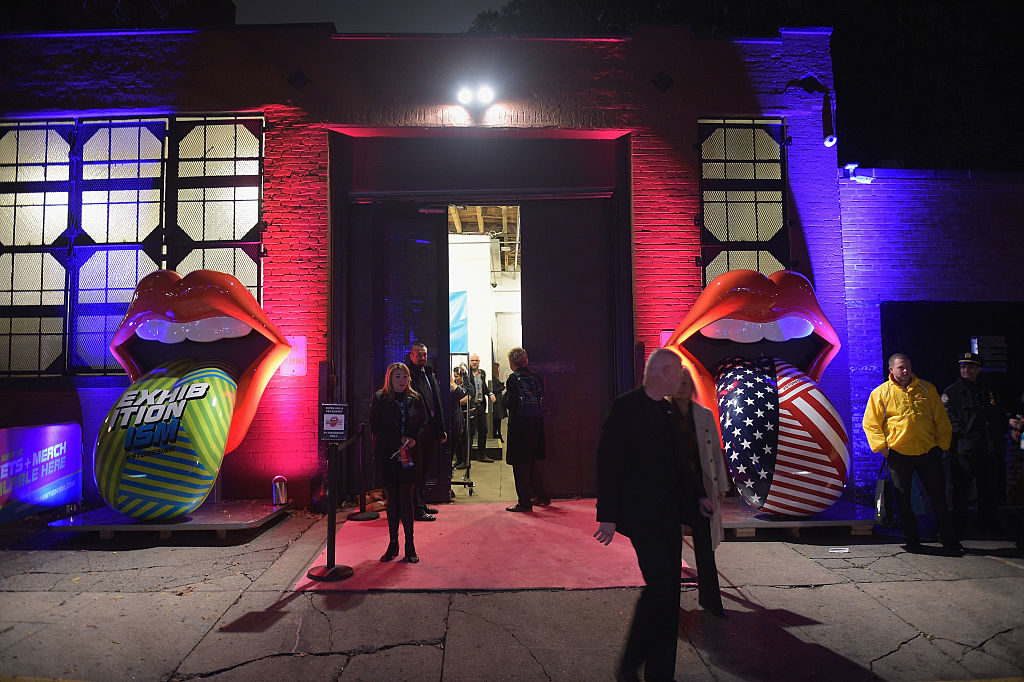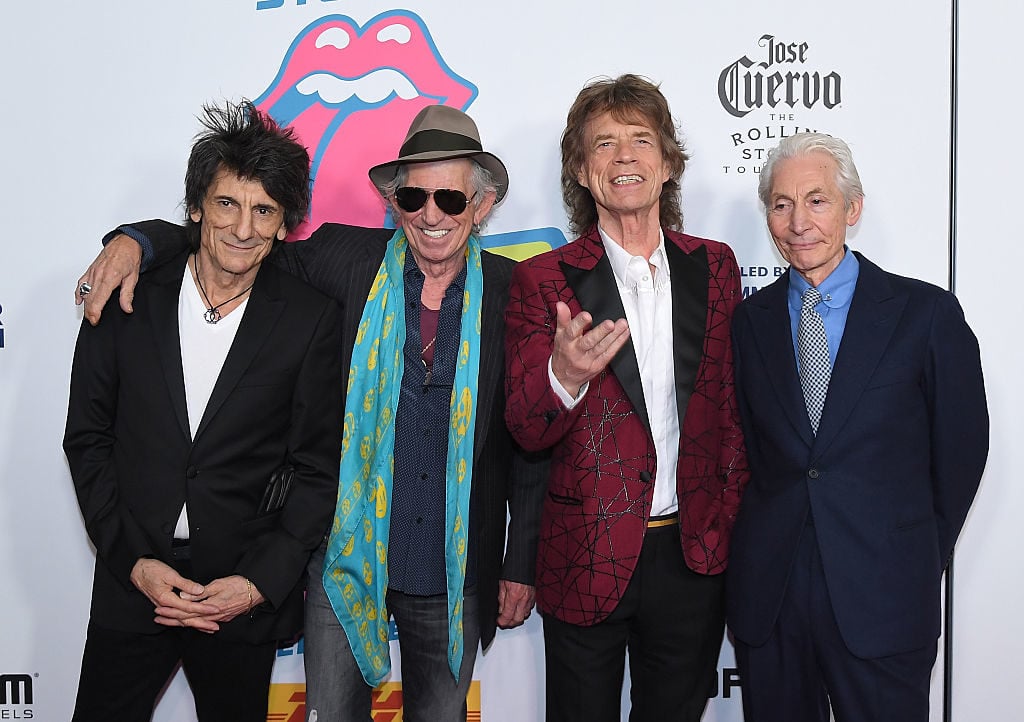Art World
Anthony Haden-Guest on Excess and Design in the Rolling Stones’s ‘Exhibitionism’
The exhibition was modeled after David Bowie's hugely successful London show.

The exhibition was modeled after David Bowie's hugely successful London show.

Anthony Haden-Guest

“Exhibitionism,” a show that presents the remarkable half-century (or more) trajectory of the Rolling Stones, and which just opened at Industria on Washington and West 12th, is a somewhat slimmed-down version of the show which occupied two floors of the Saatchi Gallery on London’s Kings Road for much of the year. The template was clearly the David Bowie show that opened at London’s Victoria and Albert Museum in the spring of 2013, which went on to become London’s most successful museum show ever, prompting an international tour when it closed. It will arrive in Tokyo early next year.
The shows are as different as the acts, though. David Bowie had an active art brain, being briefly the publisher of Modern Painters and a shrewd collector. This sensibility was reflected in his periodic re-fabrications of his persona. I saw him live at The World on Avenue C with is new noise band, Tin Machine, which was great. And short-lived.
Recommended: The 2017 Whitney Biennial Will Feature Edgy, Trending Artists in ‘Turbulent’ Times
The Rolling Stones though have always been the Rolling Stones, and “Exhibitionism” does an excellent job of dishing up the what, the where, and the how. It also does an fine job of showcasing what has been one of the group’s singular contributions to rock and roll, which was perfecting the notion of the rock tour as a dramatic form—an art form, okay?—in itself. Mick Jagger’s doing mostly. First, though, some constituent parts.
You’re instantly plunged into a fast-moving sequence of images on an array of different video screens, including clips of live performance footage and tabloid headlines that blare: “TWO ROLLING STONES ARRESTED,” “KEITH RICHARDS BUSTED,” and “FESTIVAL OF HORROR CONTRASTS WITH WOODSTOCK PEACE,” the last of which deals with the knifing death inflicted by the Hells Angels at Altamont.

A general view of statues outside the exhibit as The Rolling Stones celebrate the North American debut of “Exhibitionism” at Industria in the West Village on November 15, 2016 in New York City. Photo by Jason Kempin/Getty Images for for The Rolling Stones.
The early dominance of Brian Jones zips by in the headlines, “RIFF RAFF WHO CARES? BRIAN JONES,” and “BRIAN JONES QUITS STONES.” This is later upended by the band’s first contract, signed by Brian Jones and the Stones manager, Eric Easton. A text explains that the contract was signed by Easton because Andrew Oldham, the Stones’s manager, wasn’t old enough to sign. Wow!
The death by drowning of Brian Jones is not referenced—that I could see. But that was after he had left the band. Another interesting element here is footage from Cocksucker Blues, the documentary that the Stones commissioned from Robert Frank to cover the 1972 tour Exile on Main Street and promptly quashed after they had taken a look at it. And the clips which offer glimpses of jaunty groupie bottoms and pubes will tell you just why. Good to see this much anyway.
Recommended: What the Art World Looks Like to Trump Strategist Stephen Bannon
One chronologically early element in “Exhibitionism”—a great title—is the recreation of the apartment that Mick Jagger, Brian Jones, Keith Richards, and a friend, James Phelge, shared in Edith Grove, Chelsea, in 1962. What with the eggshells in the kitchen, the milk bottles breeding cultures, the grease-clogged frying pan, brimming ashtrays, garishly ratty linoleum, rock and roll poster—Alexis Korner and Blues Incorporated at the Woodstock Hotel, Cheam, (antedating that other Woodstock), a dreary landscape hanging askew in the multiple bedroom, and album covers such as The Best of Muddy Waters and Chuck Berry rockin’ at the hops—so convincingly appalling an installation is this that it would deserve museum space even with no Stones connection whatsoever. I lived in Chelsea in 1962, by the way, and I’m guessing that the rent was $20 a week, tops.
The photography in the show includes work by, amongst others, David Bailey and Helmut Newton. There are five pictures by Newton, taken in a 1978 recording session at the Pathe Marconi on the Rue de Sevres during the Stones’s year in Paris; this includes one image showing Ronnie, Mick, Charlie, Bill, and Keith, who appears to be blowing out a whale-like spume of … well, maybe it was water.

(L-R) Ronnie Wood, Keith Richards, Mick Jagger, and Charlie Watts of The Rolling Stones attend The Rolling Stones North American debut celebration of “Exhibitionism” at Industria in the West Village on November 15, 2016 in New York City. Photo by ANGELA WEISS/AFP/Getty Images.
Jagger is quoted, saying:
It was a very new development, that famous photographers would take pictures of rock bands. Suddenly we became part of the whole ‘60s phenomenon, breaking through the boundaries of Pop music into fashion, films, television, and everything else.
The “everything else” should be taken to include art and design, by the way. “Exhibitionism” includes Richard Hamilton’s striking 1968 print, Swingeing London 67, which appropriated a photograph of Mick Jagger and Robert Fraser, taken in the back of a police car, where they’re seemingly trying to hide their faces after a drug bust, yet also apparently trying to wave.
It also includes a number of Warhols, which are by no means among the master’s strongest works (his zipper cover for Sticky Fingers was way, way more powerful), and a certain amount of design that works as fine art, such as Hubert Kretschmar’s various iterations of the artwork for the 1978 album Some Girls.
So, naturally, to the design of the shows. Models and images suggest what went into the staging of the tours, Steel Wheels, Urban Jungle, Voodoo Lounge, Bridges to Babylon, and Bigger Bang. Jagger is quoted revealingly in a wall text as saying:
I was particularly interested in the beautiful bridges that Santiago Calatrava was designing in Seville and elsewhere. When we were designing the staging for the Voodoo Lounge Tour, I had said to Mark Fisher—of the design outfit, Fisher Park—“I want to have this bridge; we’ll have the main stage there, and then we can have a bridge to here, here, and here.” Mark just said “Oh, what a useless idea!” So when the Bridges to Babylon Tour came around, Mark threw my own idea back at me. He said, OK. If you give me a million dollars I can make a bridge that will emerge from the stage and land on B stage. And I said, “It’s a go.”
Is that a bridge too far from the art world of today?